| |
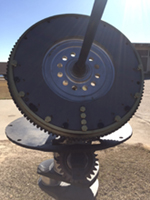 |
Opp |
Alabama |
USA |
Equatorial Dial |
Dial 895 |
| An equatorial sundial made of diesel engine parts by the students of Lureen B. Wallace Community College, under the guidance of Eddie Spann, instructor for diesel and heavy equipment and designed by the college president, Dr. Herbert Riedel. The stand is a crankshaft from a Cummins engine, while the dial base and dial faceplate are flywheels. The gnomon is a heavy duty diesel cylinder liner puller. The gear teeth on the faceplate mesh with a small gear to allow easy adjustment for the equation of time. Hours are marked by bolts, and on the winter side are painted hour numbers. |
| |
| |
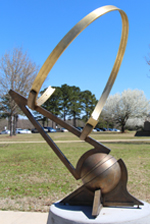 |
Andalusia |
Alabama |
USA |
Reflective Equatorial |
Dial 894 |
| This dial is one of Bill Gottesman's uniquely designed Renaissance dials of cast and structural bronze with a 27 inch diameter time telling helix whose axis is aligned to the celestial-north pole. Time is told by a focused beam of light from a long cylindrical unsilvered mirror situated on that N-S axis, reflecting sunlight into a slit of light onto the helix, telling time throughout the day. A sliding time scale within the helix is adjusted for longitude, date's equation of time correction and daylight saving time. Once this scale is adjusted for date, the dial shows civil (local clock) time with an accuracy of under one minute. The dial base is cast bronze that allows adjustment for latitude and is placed on a sandstone plinth. |
| |
| |
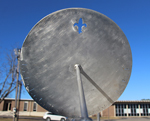 |
Opp |
Alabama |
USA |
Equatorial Dial |
Dial 893 |
| This 2-foot diameter equatorial disk is of quarter-inch aluminum plate with hourly time marks cut through with slots. Shorter slots mark half our and fifteen minute intervals. The noon mark is surrounded by short holes made at five minute intervals. At the top of the dial is a cut fleur de lis. |
| |
| |
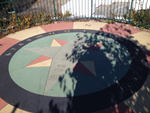 |
Grand Rapids |
Michigan |
USA |
Analemmatic Dial |
Dial 892 |
| The brightly colored analemmatic dial is approx 10.5 feet in diameter, surrounded by a ring of alternating red and white concrete with cardinal points. Time marks are set in a ring of black concrete, with large engraved hour numbers. Time is adjusted for daylight saving time.[Note that to tell time correctly, the time marks should be set on an ellipse.] The walkway for standing to cast your shadow has monthly names impressed into the concrete. |
| |
| |
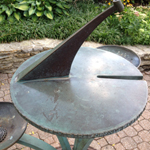 |
St. Louis |
Missouri |
USA |
Horizontal Dial |
Dial 891 |
| This horizontal sundial is part of a sculpture set, formed as a lily pad, and surrounded by three circular flowers with centers that are small water fountains (no longer working). The dial face is no longer flat and the graceful gnomon does not point true north. There is a short cylinder at the end of the gnomon with a hole, perhaps for casting a beam of light on a certain day. The hole is at a 34.4 deg angle, aiming toward the slot in the dial face. Now, the dial is located in dense shade preventing operation. |
| |
| |
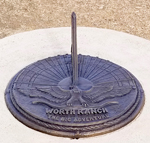 |
Palo Pinto |
Texas |
USA |
Horizontal Dial |
Dial 890 |
| The 21 inches in diameter sundial started as a sculpture. A call went out to the boy and girl scouts (and alum men and women) to contributed fossils, and other artifacts. This included an arrowhead found at camp. These objects were incorporated into the finished wax, with the arrowhead embedded on the style edge at the very tip of the gnomon. A mold was taken of the completed sculpture and used to create a casting wax replica of the sculpture. |
| |
| |
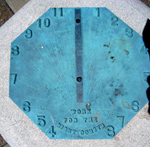 |
St. Louis |
Missouri |
USA |
Horizontal Dial |
Dial 889 |
| Sitting on a classic sundial pedestal is the Concordia sundial made of thin bronze plate in the shape of a hexagon about 8 inches between opposing sides. Hour lines radiate from where a thick gnomon would have stood, with Arabic numbers from 4am to 8pm counting the hours. The gnomon had gone missing in 2009 when the dial was vandalized. A new gnomon fitting the position of the old was designed by Don Snyder of St. Louis and made of bronze plate by William Turner of Turner & Associates, a metalworker also of St. Louis. |
| |
| |
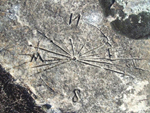 |
Monegaw Springs |
Missouri |
USA |
Sun Alignment |
Dial 888 |
| This compass is carved in rock showing cardinal points. For some reason the N mark is backward and a W mark is upside down. A surrounding circle of 10 inches in diameter defines most of the compass. A smaller circle encompasses the letter N and a partial circle carved from the center is approximately 4 inches in diameter. |
| |
| |
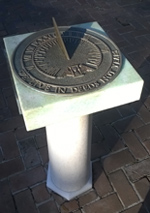 |
Natchez |
Mississippi |
USA |
Horizontal Dial |
Dial 887 |
| In 1716 the French built a fort on the bluffs of Natchez and named it Rosalie in honor of the Countess of Pontchartrain. In 1820 Peter Little, who came to Natchez from Pennsylvania in 1798 at the age of 17, purchased a portion of that land on which to build his home. He decided to keep the name Rosalie in honor of the fort and its settlers. The mansion and land was purchased in 1938 by Mississippi State Society, Daughters of the American Revolution. |
| |
| |
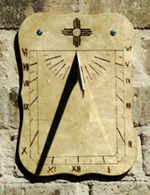 |
Ridgeland |
Mississippi |
USA |
Vertical Dial |
Dial 886 |
| This is a small 7 x 10 inch vertical dial declining due south. It is made from wood with hour lines, half hour lines, and Roman numerals engraved using a wood burning tool. The simple gnomon is 1/8 inch steel. |
| |
| |
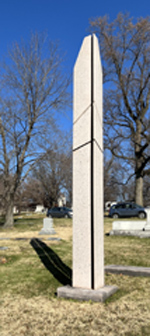 |
St. Louis |
Missouri |
USA |
Obelisk or Vertical Gnomon |
Dial 885 |
| The obelisk is constructed of North Carolina pink granite. At the base it is 18 x 16 inches and soars 18 feet into the sky. The obelisk displays a cross in its own shadow at solar noon on two days each year – the summer solstice on about June 21, and the winter solstice on about December 21. William Conrad Severson (1924-1999) was a St. Louis sculptor whose public artwork celebrated the sun. Examples are Solaris located at TECO Plaza in Tampa FL, Cosmos located in Saudi Arabia, and the sculptures of Les Danseuses and Primogenesis, both located in Clayton MO. Severson designed and had built the memorial obelisk for his family grave site, where he now rests as well. |
| |
| |
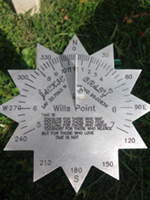 |
Wills Point |
Texas |
USA |
Horizontal Dial |
Dial 884 |
| This starburst sundial is 6-3/4 inches in diameter, made of 1/8 inch aluminum plate. The dial is actually set in a 12-point compass rose, showing the azimuth every 30 degrees. Time marks are every 15 minutes with hours in Arabic numerals. All marking, latitude, longitude, and inscription are engraved into the dial plate. |
| |
| |
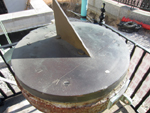 |
St. Louis |
Missouri |
USA |
Horizontal Dial |
Dial 883 |
| The circular bronze dial sits on an iron pipe, surrounded by a picket fence and protected from the elements by a brass hood. It is a nearly identical dial to the one at the St. Louis Arsenal (NASS dial #847), and was manufactured in the same year, 1859. It is likely that master armorer N. Engels, machinist A. Schaedel, and engraver W. Hawksley created this dial. The Old Courthouse Dial measures 17 inches in diameter, has a large unadorned triangular gnomon, and on the plate has hour lines from 6am to 6pm delineated every 15 minutes. There is a curious second set of hour lines at the top of the dial plate from 10am to 2pm. Hour numbers are in Roman numerals. There are no other engravings on the dial. |
| |
| |
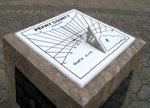 |
Perryville |
Missouri |
USA |
Horizontal Dial |
Dial 882 |
| The square 14.5-inch dial is made of while milk stone with graphics highlighted using lithochrome paint. The gnomon is made of stainless steel 303-alloy and has the letter P held between the base and style. The dial sits upon a square frustrum pedestal 3-feet tall, 24-inches square at the base, tapering to 17.5-inches at the top. The pedestal is supported on a 32-inch square base. |
| |
| |
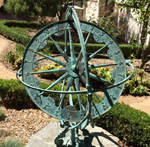 |
La Canada |
California |
USA |
Armillary Sphere |
Dial 881 |
| The bronze equatorial dial is about 24" diameter, and has equatorial, meridian and horizon rings. It sits on top of a stone pedestal. The equatorial ring is supported by 24 spokes, spaced at 15 degrees. Around the rim 24 hour numerals in Arabic. The twelve signs of the zodiac are spaced every other hour on the equatorial rim. The orientation to true north and inclination were verified to be correct for the site. The sundial was a gift from the Kresser Smith family to the Descanso Gardens Guild in 1987 on the occasion of the guild's 30th anniversary. |
| |
| |
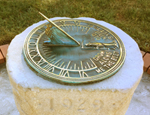 |
Washington |
District of Columbia |
USA |
Horizontal Dial |
Dial 880 |
| This simple bronze sundial about 12 inches in diameter sits on a 3-foot fluted plinth made from Indiana limestone. Embossed hour lines extend from 5am to 7pm delineated every 15 minutes. Surrounding the hour chapter are Roman numerals with the noon hour marked by "0". The gnomon is very attractive, with a bird ensconced between the style and base. The dial was given to Howard University by the Lampados Club of Alpha Chapter, Omega Psi Phi Fraternity in 1929 to honor Benjamin Banneker, 18th century astronomer, surveyor and executing architect of the District of Columbia. |
| |
| |
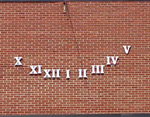 |
Danville |
Vermont |
USA |
Vertical Dial |
Dial 879 |
| A simple vertical dial created on the front brick wall of the high school. There are no hour lines, but large Roman numerals are placed from 10am to 5pm to delineate the hours using Daylight Saving Time (where the 1pm hour is on the vertical). The gnomon is a simple rod. |
| |
| |
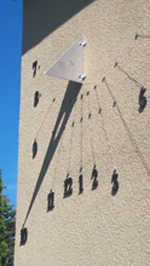 |
Regina |
Saskatchewan |
Canada |
Vertical Dial |
Dial 878 |
| This vertical dial is mounted directly onto the stucco wall of the house. The gnomon is a triangle of aluminum cut from 3/16 inch sheet, with a 2-inch hole as a breather to relieve stress from cross winds. More interesting are the hour lines, made of a double strand of heavy copper wire, with each extending from winter to summer solstice, held with pegs (from Canadian Tire). A middle peg shows the equinox as well. Hour lines extend from 7am to 6pm, shown in simple Arabic numbers. The sundial is operational in clear weather from 8:30am - 6pm through all seasons. |
| |
| |
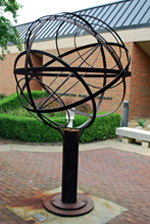 |
Williamsburg |
Virginia |
USA |
Armillary Sphere |
Dial 877 |
| This armillary is constructed of welded carbon steel narrow bands approximately 4-feet in diameter sitting on an iron post about 3-feet high. The equatorial band has no engraved or embossed time marks, but the simple rod gnomon has two side rods. According the the WPL website, "Time on the sundial is read by looking at where the gnomon shadow is cast. This shadow will be the middle, thicker shadow of the three shadow-lines ... Although hours are not marked off on this sundial, you can estimate the time of day by thinking of the gnomon shadow hoop as the clock face and the shadow as the hour hand of that clock." Well, not exactly. The hours are at 15-deg intervals with 12 noon at the bottom of the equatorial band at the intersection of the meridian band. This armillary is more of a sculpture than a timepiece. Yet the armillary has the traditional tropic of Capricorn and Cancer bands as well as Arctic, Antarctic,and horizontal bands. |
| |
| |
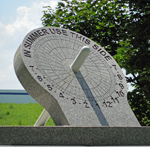 |
Hawthorn Woods |
Illinois |
USA |
Equatorial Dial |
Dial 876 |
| This equatorial dial sits on a 61-inch octagonal base that serves as a columbarium. The dial is reminiscent of Erickson Memorial sundials. This granite sundial is 38.5 inches in diameter and 6 inches thick. The 3-inch diameter gnomon is made of hollow galvanized steel pipe with a white powder coating. The engraving on the sundial was done using a rubber stencil and sandblasting with aluminum oxide abrasive. No water jet was used. The center core hole was cut using a diamond segmented coring machine, like a big drill press with an expensive hole saw. |
| |
| |
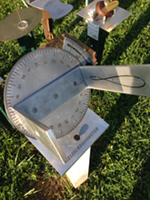 |
Lancaster |
Pennsylvania |
USA |
Heliochronometer |
Dial 875 |
| This 7.5 inch diameter heliochronometer was milled out of aluminum and set to the site latitude with a mounting plate. One heliochronometer arm has a sun illumination counter sunk hole 0.125 inch in diameter and on the other arm an engraved analemma for proper pointing offset to display civil time. Time marks are milled at 5 minute intervals, and a vernier is added (5 lines 4 minutes apart) so that time can be read to the nearest minute. |
| |
| |
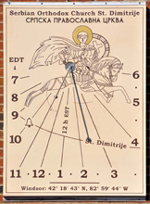 |
Windsor |
Ontario |
Canada |
Vertical Dial |
Dial 874 |
| A vertical stone sundial made of white quartzite approximately in a 6 x 4 feet rectangle. The dial face includes engraved hour lines from 7am to 6pm in Arabic hour numerals for Eastern Daylight Time and an elegant engraved outline of St. Dimitrije based on a partially preserved 14th century fresco of the Saint in St.Mary's Church, Donja Kamenica, Serbia. Rather than summer and winter solstice lines, a single hyperbola indicates the route of the gnomon shadow's tip on 8 November - the day of St.Demetrius (St. Dimitrije). In fact, the gnomon is represented at St. Demetrius' sword (or more appropriately, his spear). A small bell is engraved at 10am indicating the time of morning liturgy. At about 11:15 if you look closely, you can see the subnode point (polos montaza) of the gnomon tip used for alignment during construction. |
| |
| |
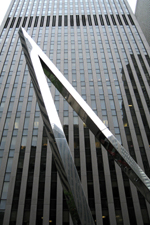 |
New York |
New York |
USA |
Sculpture/Artwork |
Dial 873 |
| The Sun Triangle is a 50-foot sculpture of polished stainless steel set upon a leaning 20-foot stainless steel pole, creating a futuristic look. The sides of the triangle are aligned such that steepest side points to the sun at noon for the summer solstice at an altitude of 73 degrees at solar noon (12:48pm Daylight Saving Time) while the lower side of the triangle points to the winter solstice at an angle of 26 degrees. The upper side and longest side of the triangle points to the the noonday sun on the spring and fall equinoxes. |
| |
| |
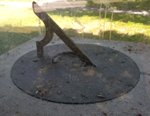 |
Augusta |
Maine |
USA |
Horizontal Dial |
Dial 872 |
| This historic brass dial is about 18 inches in diameter, set upon a square, concrete pillar. The dial plate has Roman numbers and is delineated in quarter hours. Magnetic variation is engraved at degree intervals. The dial originally had a removable wood cover, then a metal one, which became permanently closed. It was removed in 2009 and now has a plexiglass cover. From Betty Adams in the Kennebec Journal, "At the uncovering, a half dozen people strained to read some of the lettering on the dial: 'Arc for magnetic variation', [and on an interior circle] 'Moses B. Bliss - Circumferentor' which means surveyor's compass... The meridian monument was one of those erected at county courthouses in Maine between 1869 and 1871, according to research by Harold E. Nelson, senior geodesist at the Maine Department of Transportation's property office...Nelson said the monument would have been used by local land surveyors to test their compasses against true north." |
| |
| |
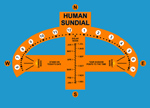 |
Oro Valley |
Arizona |
USA |
Analemmatic Dial |
Dial 871 |
| This analemmatic sundial is painted on concrete. It is similar to John Carmichael's human sundial at Flandrau Planetarium at the University of Arizona. The orange background was painted by hand with acrylic paint on top of the blue acrylic court surface. Lettering and other markings were painted with Rustoleum spray enamel using stencils from Stencilease.com. Final touch up painting was done by hand. It took a three man team ten days to paint. It's quarter hour time marks are longitude corrected and shows Standard Time when readings are adjusted using the Equation of Time. It includes a central Date Line for standing, using monthly and weekly marks. There is a Solar Noon mark, and Bailey Points to indicate the direction of sunrise and sunset. |
| |
| |
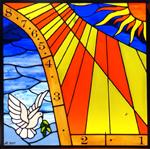 |
Waring |
Texas |
USA |
Vertical Dial |
Dial 870 |
| This is a rare American stained glass sundial, accurately telling time and season. It occupies the center panel of a five panel window that forms a cross. The vertical sundial panel measures 28x28 inches and declines 48° west of south, so it only functions in the afternoons. The dial is longitude corrected and indicates Daylight Saving Time when readings are adjusted using the Equation of Time. The gnomon is a 3/4 inch brass ball nodus attached by a non-polar axis rod to the aluminum Sussman window frame. It is the only stained glass sundial in the world that uses frosted colored stained glass to enhance the view of the nodus shadow. It has three seasonal date lines, a solar noon mark, and other marks showing special anniversary dates. It contains the traditional fly, seen on the the lower yellow panel between 1pm and 1:30pm. |
| |
| |
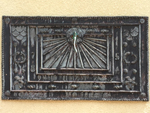 |
Gainesville |
Florida |
USA |
Vertical Dial |
Dial 869 |
| The oblong 28 inch long x 14 inch high vertical dial appears to be cast aluminum, painted black, but with much of the paint worn off. The dial plate is surrounded with a motif of decorative fish, star fish, shells and scales. The hour lines are most peculiar. The lines are numbered from 7am to 5pm, but there are two more morning and evening hour lines, none of which are horizontal that would be expected for 6am and 6pm. In laying a proper set of hour lines for latitude 29.658 on top of a photograph of the dial, the hours from 9am to 3pm appear nearly correct. The 8am and 4pm hour lines appear at what is really 8:30/3:30, the 7am and 5pm hour lines appear at what is really 8:00/4:00. The last two dial hour angles for morning or evening are totally irreconcilable. The brass gnomon, in the shape of a downward pointing arrow, is bent, but perhaps more disconcerting is that it is mounted on a pivot, indicating that it can be moved to different latitudes. The dial, although decorative, certainly is not a worthy timepiece. |
| |
| |
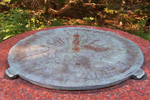 |
Bay Fortune |
Prince Edward Island |
Canada |
Horizontal Dial |
Dial 868 |
| A brass, horizontal dial about 14 inches in diameter sits on a stone pedestal with a red marble cap. Embossed Roman numbers mark the hours from 4am to 8pm, and delineated every 10 minutes. Radiating from the center are pointed leaves to each hour. The dial plate green patina is marred by graffiti and the gnomon has broken off. A restoration for this dial is planned using the original gnomon. |
| |
| |
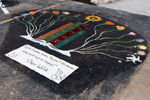 |
Kokomo |
Indiana |
USA |
Analemmatic Dial |
Dial 867 |
| This brightly decorated analemmatic sundial is painted on the asphalt to look like a book turning into flowers, showing the combination of literacy and nature. The dial is approximately 10 foot wide with hour marks from 5am to 7pm with drawings of various flowers. Noon is marked with a large sunflower. The central walkway is simply done with the abbreviated names of the months, one column in green, the other in red. |
| |
| |
 |
Gainesville |
Florida |
USA |
Armillary Sphere |
Dial 866 |
| As the tour pamphlet states,"The striking armillary sphere sundial, donated in 1986 by the Gowan family, terminates an important sight line from the Turtle Court. Two Washingtonia palms stand like tall sentries as visitors cross the arcade from the Turtle Court to the sundial." The bronze dial about a meter in diameter has a 3-inch bronze equatorial band with Roman numeral hour marks on the interior and signs of the zodiac on the exterior. The gnomon is a arrow rod that fits the "massiveness" of the sundial. All sit on an ornate granite pedestal that in turn sits on a square dais elevated about 6 inches from the ground. |
| |
| |
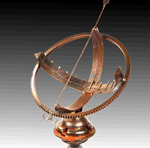 |
New Berlin |
Wisconsin |
USA |
Equatorial Dial |
Dial 865 |
| This whimsical yet elegant equatorial dial is made from old farm implements. The materials are high carbon steel and cast iron parts. The 18-inch gear is a flywheel from an International Harvester farm tractor. The base is a harrow blade for tilling soil. The harrow blades ride on a square shaft and the blades are separated by spacers seen the base of the sundial. The meridian arcs are soil tillers that would ride on a drum behind the tractor. These pieces are very challenging to weld because they are dissimilar materials. Horseshoe nails mark the hours on the equatorial arc. No hour numbers are used, just the nails. The gnomon is an arrow rod. |
| |
| |
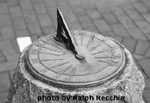 |
Raleigh |
North Carolina |
USA |
Horizontal Dial |
Dial 864 |
| Known as the Primrose Sundial, the bronze dial plate is a little more than a foot in diameter and sits on a small stone pillar about four feet high. The dial has simple hour lines from 4am to 8pm marked on the hour in Roman numerals. The open bronze gnomon is about 1/2 inch thick, held by both tenon and two large screws. |
| |
| |
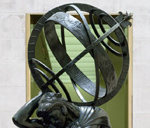 |
Houston |
Texas |
USA |
Armillary Sphere |
Dial 863 |
| The armillary sundial is part of the statue Hercules Upholding the Heavens. The statue portrays the ancient Greek hero Hercules performing the eleventh of his twelve labors, holding the heavens on his back for Atlas. The bronze sculpture is 1,650 pounds and over 10 feet tall. In 1917 Paul Manship was asked by Charles Schwab (Bethlehem Steel) to create this sculpture for his garden at his newly completed mansion. |
| |
| |
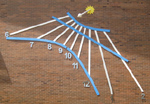 |
Newport News |
Virginia |
USA |
Vertical Dial |
Dial 862 |
| This vertical dial declines 28 degrees east, and was commissioned as educational artwork for the new Discover STEM Academy (Magruder Elementary School). The dial is 21 feet wide and 14 feet tall consisting of quarter inch by 3 inch aluminum planks for the hour lines and 4 inch aluminum pieces for the solstices and equinox lines. The hour lines are adjusted for longitude, with stainless steel Arabic numerals showing the time from 6am to 2pm at the bottom of each hour line. The gnomon is a 2 inch rod 40 inches long with a 6-inch nodus ball set back slightly from the rod end. The gnomon is held to the wall by an 18 inch yellow sun. |
| |
| |
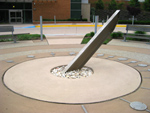 |
Woodbridge |
Virginia |
USA |
Horizontal Dial |
Dial 861 |
| This horizontal dial sits on a low concrete dais 13 feet in diameter. At the interior is an oculus 3 feet in diameter with loose gravel from which a 10-inch I-beam gnomon emerges. The I-Beam extends approximately 4 feet into the air with the north end cut vertical to the ground and then canted back creating a graceful taper on the underside. The dais concrete is of two colors: an inner pink ring 9 feet in diameter and an outer earth-toned ring that serves as a 2 foot wide chapter ring. |
| |
| |
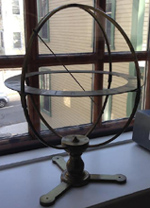 |
Providence |
Rhode Island |
USA |
Armillary Sphere |
Dial 860 |
| This 18th century dial is made by Benjamin Martin an instrument maker in London. It is bronze, approximately 18 inches in diameter. The gnomon rod is held by an meridian circle attached to a heavy bronze pedestal with three legs. The horizontal time ring, held by the meridian ring and an east-west ring as well, is engraved with Roman numerals. |
| |
| |
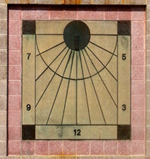 |
Providence |
Rhode Island |
USA |
Vertical Dial |
Dial 859 |
| This is a traditional vertical dial approximately 4 x 6 feet. The dial is surrounded by a row of square pink concrete brick. The dial backdrop itself is concrete with decorative dark block squares in each corner. The dial consists of a simple metal frame with hour lines that radiate from a small top central circle, all well proportioned. Hours of 7, 9, 12, 3, and 5 are marked with Arabic numbers, keeping the dial face simple. No solstice or equinox lines, but there is an artistic circular arc surrounding the central circle. Unfortunately the rod gnomon is completely missing. |
| |
| |
 |
Providence |
Rhode Island |
USA |
Vertical Dial |
Dial 858 |
| The 3 x 4 foot vertical dial is set high in the ashlar sandstone wall of Wilson Hall, the original Physics Building. In the middle of the dial is the Brown University shield, holding the gnomon rod. Surrounding the shield are hour lines. In the original 1890 architect's drawing, the hour marks were Arabic numbers from 6am to 6pm, but as built, the numbers were engraved Roman numerals and set inside the hour lines. Half hour marks were added as well. No longitude offset is made such that the noon hour line is vertical. |
| |
| |
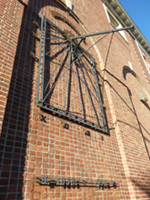 |
Providence |
Rhode Island |
USA |
Vertical Dial |
Dial 857 |
| The vertical dial is a metal frame approximately 4 x 5 feet set high on a brick wall. Within the frame are metal hour lines from 6am to 5pm marked by Roman numerals. The hour lines are adjusted for the dial's longitude to show time for the 75th meridian. Metal lines for the solstices and equinox are set for the shadow of a small spherical nodus on the gnomon rod. The gnomon itself is anchored to a bronze plate stylized as the Sun. |
| |
| |
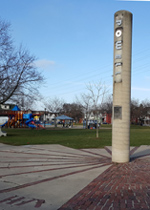 |
Hamilton |
Ontario |
Canada |
Obelisk or Vertical Gnomon |
Dial 856 |
| At first glance this appears to be a gnomonic dial with a concrete vertical gnomon about 15 feet tall casting its shadow onto a horizontal dial face about 60 feet in diameter in a slightly irregular pattern at one corner of a grass park. But something is seriously wrong for this to be a working sundial. Gnomonic dials tell time by the tip of their gnomon. The size of the gnomon implies that only several hours around noon in the summer could possibly tell time. We would expect that the gnomon is displaced from the center of the hour lines proportional to the height times tangent of the latitude. But here, the brick hour lines radiate centrally from the gnomon. More interesting, the hour lines (and their Roman numeral hour designation) are separated by a nearly uniform increment of 18 degrees per hour. That is, only five hours marks span from North to East. |
| |
| |
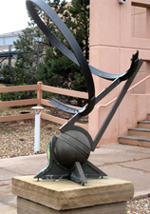 |
Golden |
Colorado |
USA |
Reflective Equatorial |
Dial 855 |
| This dial is one of Bill Gottesman's uniquely designed Renaissance dials of cast and structural bronze with a 27 inch diameter time telling helix whose axis is aligned to the celestial-north pole. Time is told by a focused beam of light from a long cylindrical unsilvered mirror situated on that N-S axis, reflecting sunlight into a slit of light onto the helix, telling time throughout the day. A sliding time scale within the helix is adjusted for longitude, date's equation of time correction and daylight saving time. Once this scale is adjusted for date, the dial shows civil (local clock) time with an accuracy of under one minute. The dial base is cast bronze that allows adjustment for latitude and is placed on a sandstone plinth. |
| |
| |
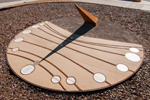 |
Alburquerque |
New Mexico |
USA |
Horizontal Dial |
Dial 854 |
| This was a unique horizontal sundial designed for the Nob Hill Main Street program, where the sundial anchored the southeast corner of the Nob Hill Community Garden. Created several years ago by Mike Heighway and Mira Rose, Mike explained, "The purpose of the Nob Hill Sundial is to act as an interactive gardener’s guide. It works on an annual cycle by casting a shadow from a large center piece (the gnomon) onto a concrete plate with embedded steel [diurnal] bands and porcelain tiles that describe that month’s gardening activities." The dial itself was about 10 feet in diameter with an metal, rust-colored gnomon. The sundial is designed around the summer and winter solstice, since these are ultimately the times of year when the sun is either at its highest or lowest point in the noon sky. Each horizontal band connects to two tiles; one side for months approaching the summer solstice, and the other for months approaching the winter solstice. The tiles instruct people what monthly activities to do in the garden. |
| |
| |
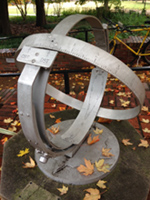 |
Nashville |
Tennessee |
USA |
Equatorial Dial |
Dial 853 |
| The equatorial dial made of aluminum operates on a unique principle. The equatorial time ring is allowed to rotate. Fixed to it on the upper ring section is a small hole that shines to the ring below. On the lower ring section is a plate with an engraved analemma, extending +/- 23.44 deg from the equator. The whole assembly is rotated until the sunlight spot falls on the analemma (with monthly marks to avoid ambiguity). One tells time using 5-minute time marks on the upper section of the equatorial ring read by one of two indicators either as central standard or daylight savings time. |
| |
| |
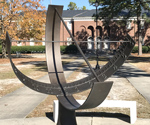 |
Wilmington |
North Carolina |
USA |
Equatorial Dial |
Dial 852 |
| This is a bronze hemispherical equatorial sundial approximately 30 inches in diameter. The wide equatorial band is delineated every quarter hour and has cast Arabic numerals as hour markers from 6am to 6pm. The meridian band is inscribed with markers for the solstices and cross-quarter days. |
| |
| |
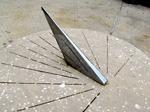 |
New Orleans |
Louisiana |
USA |
Horizontal Dial |
Dial 851 |
| The concrete dial is 32 inches in diameter with simple hour lines without any further ornamentation. The foot high gnomon is a stainless steel wedge, tapering slightly from base to top. An interesting effect of looking at the sundial and gnomon: by moving your head, the hour lines reflected in the gnomon can line up with lines on the other side of the gnomon. The dial sits on a 3 foot high concrete pedestal. |
| |
| |
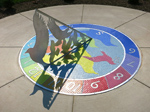 |
Washington |
District of Columbia |
USA |
Horizontal Dial |
Dial 850 |
| This horizontal dial was commissioned by the District of Columbia Department of General Services for the newly renovated River Terrace Educational Campus. The mosaic dial is installed within a 20 ft diameter concrete plaza. The dial face is a beautifully colored spectrum of Italian Piccolo porcelain 1-inch mosaic tiles encompassing a circle 8 ft in diameter. Embedded in the mosaic chapter ring are 7-inch aluminum Arabic numbers marking the hours from 6am to 6pm and just within are letters marking the cardinal points. The aluminum gnomon is 4 ft. long and 2.83 ft tall. |
| |
| |
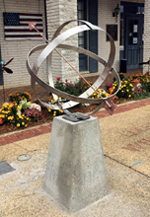 |
Lucedale |
Mississippi |
USA |
Armillary Sphere |
Dial 849 |
| The armillary is constructed of stainless steel with rings approximately 34 inches in diameter. The equatorial ring is a 3-inch band with 1-inch cast bronze Arabic hour numbers showing standard time and 1/2 inch cast bronze numbers for Daylight Saving Time. The other rings are unconventional. Rather than a horizontal ring, the ring is canted to match the latitude. The solstial ring that traditionally runs completely over the N-S vertical meridian is only 3/4 complete, creating an open area from the upper portion of the equatorial band to the southern pole that allows better viewing of the equatorial time ring when standing behind the armillary. The dial can be adjusted for the equation of time by rotating the equatorial ring to align on a plate with month marks set to the equation of time plus longitude offset, allowing the sundial to tell civil time. |
| |
| |
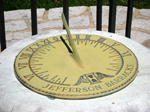 |
St. Louis |
Missouri |
USA |
Horizontal Dial |
Dial 848 |
| The original sundial, made in 1841, was 14 inches in diameter and sat on a limestone pedestal 30 inches high. In early drawings from the late 1890's and later photos, the dial had a massive triangular gnomon. For years it served as the post chronometer. |
| |
| |
 |
St. Louis |
Missouri |
USA |
Horizontal Dial |
Dial 847 |
| The circular bronze dial has a massive triangular gnomon and is kept under a protective plastic dome. In R. McGuire's book, St. Louis Arsenal - Armory Of The West is a picture of the sundial for which the caption reads "On December 12, 1859, master armorer N. Engels, machinist A. Schaedel, and engraver W. Hawksley dedicated a sundial, which they had created entirely from spare ordnance materials. It was a scientifically precise instrument, measuring 17 inches in diameter, and was used for many years as the definitive chronometer of the arsenal. Engraved upon it was a poem entitled 'The Bird of Liberty,' reflecting the patriotic fervor of the day." |
| |
| |
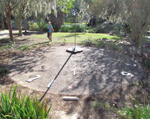 |
New Orleans |
Louisiana |
USA |
Horizontal Dial |
Dial 846 |
| Amidst the gardens in City Park is the Bacher Sundial, an 18-foot diameter pebbled concrete horizontal sundial set flush with the ground. The gnomon is well made, with curves nicely cut, edges straight, and the weld fillet is smooth and blends the upright with the base nicely. It is set on a low circular dais set considerably south of the center of the circular dial face. The gnomon is a simple iron blade 144 inches in length along the style edge. At the base, slots for anchoring the gnomon allow adjustment of 8-10 degrees to align to true north. Currently the gnomon sits near the center of the range, but can be pushed by hand to either end of the range. With loose nuts holding the gnomon, it appears canted at the base. Tightening the nuts could restore gnomon to its necessary 30 degree angle, but deterioration of the bolt anchors may prevent full tightening. |
| |